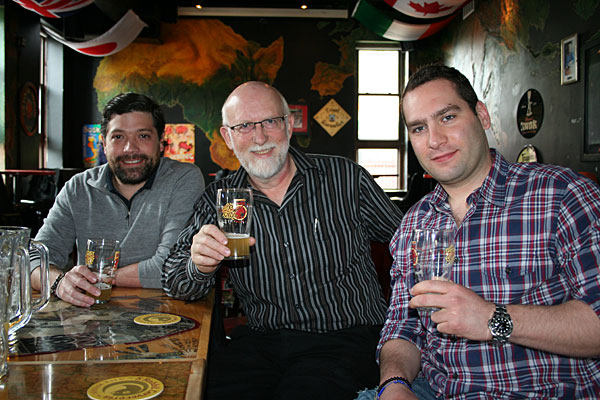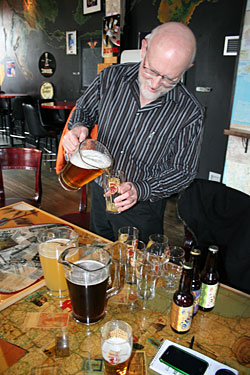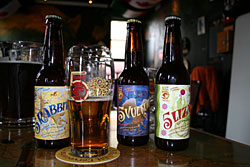
Andrés Araya, Randy Mosher, and Isaac Showaki
You read it here first (in English, at least): A new Chicago brewery, 5 Rabbit Cerveceria, will preview its beer lineup during the second-annual Chicago Craft Beer Week, which kicks off Thursday and runs through May 27 (check The 312 on Friday for photos from the opening-night party at Garfield Park Conservatory). We sat down at the Map Room with the company’s triumvirate of owners—the business consultants Isaac Showaki and Andrés Araya, and the Chicago designer and author of three books on homebrewing, Randy Mosher—to chat about their plans for 5 Rabbit, which takes its name from one of the five Aztec deities (along with 5 Lizard, 5 Vulture, 5 Flower, and 5 Grass) representing pleasure and excess.
How did the three of you come together?
Isaac Showaki: I met Andrés about six years ago, when we were working for Bain, a strategy consulting firm, in Mexico City. We had a lot of experience in Latin America and Mexico—I’m from Mexico, he’s Costa Rican—and we worked on a lot of projects together, including breweries: Florida Bebidas in Costa Rica, Heineken in central Mexico, and Cervecería Cuauhtémoc-Moctezuma in Monterrey.
We both loved working in the brewery—that smell of malt in the morning. So we started researching the industry, but we never had time to just sit down and plan it. After five years, I went to him and said, “I think the time is right.” He agreed. We spent five months writing the business plan and getting our concept together. Then we started looking for locations: somewhere with a big Hispanic community, where there was a craft beer scene that was growing, and that wasn’t that expensive. We looked at California, Chicago, Texas, Florida, and New York, and, after researching everything, we decided on Chicago.
Last year we came to Chicago for Craft Beer Week, and we met Randy Mosher at an event at the Map Room. We said hi; he liked us; we liked him. We said, “What are you doing tomorrow?” We met for lunch, we told him about our idea and our business plan. He loved it. We asked him if he would help design our logo, our labels, our packaging. A few months later we called him again and said, “Randy, do you know anyone who can help us with our recipes?” And he said, “Yeah. I know someone. Me.” After working with him for several months, we just had this incredible relationship, so we asked him if he wanted to be part of company as a partner. He did.

Randy Mosher pours a pint of 5 Rabbit at the Map Room—but hold up, beer geeks. This was a private tasting; you won’t find the beer on tap in bars until early June.
Randy, with all of your consulting and homebrewing experience, how did this particular brewery end up being the one you partnered with?
Randy Mosher: Usually, with most startup breweries, the thing they never want [to let someone else work on] is the recipes. They’ll give away the marketing or the sales or the business aspects, but the recipes and the development of the beers—that’s the fun part. These guys weren’t coming at it from a homebrewing point of view, so they needed help with the actual recipes. They had a great concept: trying to do something Latin but not historical, not precious. Just being fun and modern and finding that sweet spot between craft beer and the world of Latin flavor and cultures. And to me, that seemed like a really brilliant idea.
You’re calling 5 Rabbit the United States’ “first Latin American brewery.” What does that mean?
IS: We wanted to do something different from other craft breweries, and there’s this huge Hispanic segment in the United States. In Illinois, Hispanics make up 25 percent of the population. It’s the biggest minority group, a strong middle class. That’s a big target market. Second, we wanted to showcase our own culture through the names of the beers, the recipes, the labels, even the ingredients.
Is your plan to win over the Hispanic market first, then world domination?
Andrés Araya: One concern was that we didn’t know how ready the Hispanic market was to adopt craft beer. Some craft beers can take time to get used to—the complexity and the intensity. So if you’re used to drinking Corona, jumping to something that’s really different could be kind of far-fetched. So what we tried to do with 5 Rabbit [the golden ale] was make a beer that’s a stepping stone, that won’t scare people away with very strong flavors or strong complexity but that will give people a sense of what good beer is.
IS: So now we’re targeting the craft beer market, people who already drink craft beer, with the Hispanic market as our secondary market. We’ll see if we can convert them. We’re hoping it won’t be that hard, since the Hispanic market does drink imports, and for those you pay craft-beer prices.
In addition to serving as creative director, is Randy your brewmaster?
IS: We have an office in Avondale, but right now we’re contract brewing with Argus, a father-and-son brewery that started about a year and a half ago in Pullman. Randy designed our recipes, and he supervises the brewing, but Argus brews the beers. Our goal is to open our own brewery sooner rather than later. We want to start building by the end of 2012 and hopefully be operational by the first semester of 2013.
What has recipe development been like?
RM: We have this rapid prototyping process, where, rather than brew pilot batches first, I’ll get commercial beers that I know have specific properties—of color, bitterness, sweetness, maltiness, roastiness—in various proportions, and we’ll blend those together to try to get the beer the way we want it. Then we’ll season it with chili or passionfruit or whatever. It’s not exactly like the finished beer, but it really gives you an excellent idea so we can go on to brewing five-gallon pilot batches.

From left: 5 Rabbit (also in glass), 5 Lizard, and 5 Vulture
Let’s talk about the beers.
IS: In our wheat beer, 5 Lizard, we’re using passionfruit from Colombia. You usually use orange peel in a wheat beer, but we’re using lime, since lime is an ingredient you find in almost any Latin American dish. In our dark ale, 5 Vulture, we’re going with a raw, unrefined Mexican sugar called piloncillo, plus cinnamon, clove, caramel, and at the end we put in a little chili ancho, which gives it a nice roastiness. After you drink a couple, you have a warming sensation at the back of the throat. People seem to love it.
RM: And we certainly thought that if we’re going to do Latin beer, we need a beery-beer—but not a throwaway, not halfway to Bohemia. We wanted a beer that would be as good as Pilsner Urquell used to be: a great golden beer. A beer that we could set on the bar next to a Bohemia and say, “Everybody says this is the best Mexican beer. Try it. Now try ours,” and blow everyone away.
IS: Just like the Pepsi Challenge.
It seems like food and food pairings are especially important to you.
RM: If you look at Mexican food next to Mexican beer, the food is so bold and so vibrant and so intense, it seems kind of odd that the beers would be so bland. Once we make the connection between food and craft beer, we’re hoping it will click and make sense.
IS: It’s not just Mexican food. These beers can go with any Latin food. The 5 Lizard goes with seviche, green tamales, fish tacos. The golden ale [5 Rabbit] goes with red tamales, carne asada, fried snapper. And the 5 Vulture, with mole and barbacoa.
Once craft beer week is over, where can readers find 5 Rabbit?
IS: The first week of June, we’ll be in the market with bottles and drafts of 5 Rabbit and 5 Lizard. Then we’ll launch 5 Vulture in July or August. Our distributor is Louis Glunz, and we do have about 20 bars signed on, for sure, right now: Map Room, Publican, Bad Apple, Sheffield’s, Bottom Lounge, Hopleaf.
Is it safe to assume 5 Flower and 5 Grass will be next?
AA: Could be. Those are the rest of the five gods. We’re working on that.
Interview has been edited and condensed.
* * *
Where to try 5 Rabbit during Chicago Craft Beer Week:
• Meet & Greet with 5 Rabbit and Metropolitan Brewing at the Publican, May 25 from 4 to 6 p.m.; free with CCBW passport
• Origin of the 5 Rabbit: An Evening of Art, Food, and Beer at the National Museum of Mexican Art, May 26 from 7 to 11 p.m.; get tickets, $35, here
• 5 Rabbit tasting at Map Room, May 27 from 6 to 9 p.m.; free with CCBW passport


